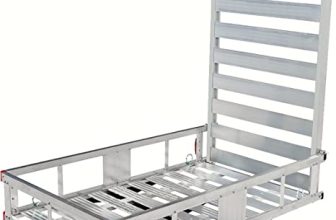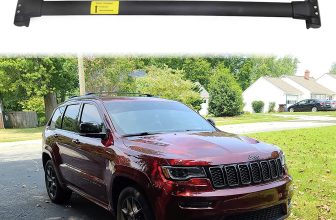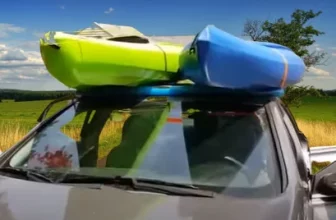Kayak on J Rack
J Rack is an easy way of transporting kayaks. The shelves are of j-shaped shapes and can easily be carried up and down perpendicularly in the car and in parking with minimal effort! A Kayak on J Rack is designed for transporting a kayak canoe or other type of boat. The structure is composed by two metal bars which connect to one another with several horizontal crosses on one side. The bars feature hooking on their slats, which allow you to attach your car to a wall or doorframe. You typically have two bars attached but don’t want to attach them on the same side.
J-Racks are roof racks which can be installed on any car. It has two sides which allows kayaking to be carried as easily as possible on a vehicle. The easiest way to install a boat on your car is to choose the maximum height required to hold your fishing rods inside and the fishing poles out (higher settings allow space). You should also make sure you are installing a compatible rack somewhere in the vicinity. These installs might require additional hardware which might require more storage space. Please check the location.

Tightening Your Racks
Tie the strap securely to your kayak to keep it in place. When trying to maintain the tightness, try pulling all four straps together evenly. If something goes loose during driving then this can cause a serious collision. When you have finished, you should take a knife or other knife to remove the remaining material from the straps before leaving! If you have little room at the back of your car, make sure you have an accurate and reliable blade.
J Rack Installation Tips
J shelves are very heavy and difficult to install if you are not extremely strong. If there is nothing to worry about, you should contact friends or other people in that area! The J rack should be mounted above the front of the car and you will mark the spots on the roof of the car once you clean thoroughly with soap and water. Use a power drill for the holes that you marked for mounting and then place it in place.
Kayak Rack Types
We will discuss a few kayak rack here to provide some other options.
1. Pads
One of the solutions to kayak jerks is to use pads. They work best when transporting kayaks without a roof rack and do not require any installation or hardware.
How do you make sure your kayak has more paddles? Set the paddles on the roof and set the kayak after the paddles before lowering the kayak down.
2. Crossbars
If you have a crossbar in your car, you can easily make a kayak strap using the bars. Make sure you choose crossbars that are compatible with you.
Always hold on to your crossbars and make sure to flip over your kayak. This will make it easier to keep your kayak straps tight.
3. Hitch Mounts
Hitch mounts are great alternatives for trucks to transport kayak in trucks. They allow you to place one end of the kayak on top of the truck’s cab while the other end is supported by a jerk crossbar.
Typical models of this rack type are compatible with standard two-inch truck hiccups. Allows you to customize the height of your setup according to your vehicle specifications as many of them also have adjustable vertical support.
4. V-Shaped Racks
Your car needs to have V-shaped racks like J-racks in your car. These require very little installation time and are very cost effective.
These jerks are made to be installed face to face with your kayak. The racks are designed V-shaped to hold your kayak underground and make it very clear where your kayak should be placed on the roof.
5. J Rack Installation Tips
We hope you understand now what J-Rack is and why J-Rack is different from other racks. So let’s see how you can properly install J-Rack in your car.
6. Vehicle Type
The first thing you need to consider when installing a J-Rack is what type of vehicle you have. These rags are best for trucks, small cars and SUVs. Because you have to raise your kayak to the height of your roof if you want to get the rack.
Higher vehicles make it harder to use the J Rack in such a truck. The rag on the roof of the car you want to install needs to be equipped with a crossbar or other type of roof rack.
7. Orientation
J rack usually come with a higher side and a lower side. In it you will find flat padded areas where your uncle’s guns will appear on the rack.
Some people prefer to install the J Rack facing away from the center of the car and facing upwards. However, most people use this setup to load their kayaks from the back of the car.
We recommend that the long side be in the center of your car when installing the J Rack. This will make it easier to load your kayaks into the car. And will have the ability to enter your car driver or door if additional height is required.
8. Security
If you live somewhere where security is a concern, consider J Rack, which has a locking system. If it is a little expensive, these will guarantee you maximum security.
9. Tightening Your Racks
Generally no additional tools or hardware are required to install J-Rugs. As a result, you have to tighten the screws of the rack by hand. This makes the process very easy.
Depending on the rack setup on the roof of your car it may seem difficult. However, you need to place the racks in such a way that the roof bars of your car do not rotate.
Otherwise, the whole rack is likely to turn and fall down when you drive. This is certainly not a good protection.
You can use a pair of channel locks or pluses to tighten the screws on your rack. If you use these, you must keep an eye on your rack so that your rag is not damaged in any way.
How to Load a Kayak on J Rack?
The transport of a paddleboard requires easy transporting the equipment. The load of the kayak onto the vehicle allows for the exploration of different waterways while building your skill for different watercraft. The best route for safe transport of the kayak is through several different ways. You have plenty of options for storing kayaks on trailers or putting them in the back of your truck and you may need to rent an inflatable kayak for transport. Those who opt for rotomolded kayaks can’t fit into a vehicle. The use of a J shelf in roofs is a very efficient way to transport kayaks.
How to Load Kayak on J Rack by Yourself?
Sometime a kayaking adventure starts with exploring new waterways. This can be done easily. The safety of kayaking is possible with a range of alternatives. It is easy for a person to transport their kayak by mounting J-Rack onto the roof. Although it can be transported quickly it requires a correct installation. This is a tutorial to help people install the J-Rack system and load kayaks using J-Rack.
Getting a kayak can be an issue for those who don’t own a huge SUV or an SUV with enough space. Most of us do not reside very close to rivers or water where we can paddle so getting your kayak to a destination is required using any mode of transport available to us. However, it’s important for us to take safety very seriously. The J rack is an inexpensive way to transport your kayak.
Loading From the Side
If you want to load your kayak yourself, you need to lift and rotate the kayak as soon as you get to the roof of the car. Strategies may vary depending on the size of your kayak.
It will be easier to load kayak on J Rack if you have a collaborator. Position the side of the kayak side, and rotate your kayak less than 90 degrees by setting the gun on the j rack while lifting.
If your partner is much taller than the other, ask the taller person to set the end of the kayak to J-Rack.
If one end were raised, the top end of the taller person’s rack could sway during placement.
Loading From the Rear
Loading the kayak on the J Rack from the back of the car is an easy task for single paddlers. If your kayak is very heavy and long, it is better to load it from the side.
First put your kayak on the ground. Align the kayak bow to the back of the car bumper and place a pad under the kayak strain.
The bow will help lift your kayak upwards, and protect your kayak from strain damage by going into the channel of the J Racks.
If the kayak’s bow gets too high, slide the kayak forward. Positioning on a pad two to three feet ahead of the kayak strain can be a good move.
This technique will help you to make sure that your kayak bow is securely attached to the J Rack before moving on to the next step. If you are not sure, you are at risk of sliding.
If you are convinced that your kayak is safe with J. Rack, it will turn around. Then you carefully lift the brace and turn the kayak so that the gunman goes to J. Rack’s channel.
Rotating will make it easier for the kayak to slide securely to the front of the J Rack channel. In longer vehicles, park your kayak next to or in the rear corner.
Lift with your legs
Kayaks can weigh a fair bit, and for that reason they can be dangerous to lift alone. It can be a particular struggle if you already have back problems which prevent you from lifting heavy things. And given we all want to kayak as much as possible, having a back injury is the absolute last thing we want to pick up!
As such we recommend always lifting with a straight back, and bend at the knees. Your back should remain as vertical as possible throughout the lift, and you should be using your legs to generate the power. They are the most powerful muscles in your body, after all!
The shoulder press method
First, you’ll want to position yourself behind the kayak, which will be laying on the floor with the bottom of the hull facing up.
Securing Your Kayaks
You need to secure it before you can drive after installing it with your Kayak J Rack. This is an area where newcomers fail most of the time. The consequences can be very bad.
For starters, you will need a reliable strap to work with. Perform the two strap technique if you are carrying a kayak in the car. But if you want to carry two kayaks, J installs a second set of racks.
It would be easy to put the kayak on the J-rags from the side of the car. If you are an expert, you can actually set your own straps before loading the kayaks.






